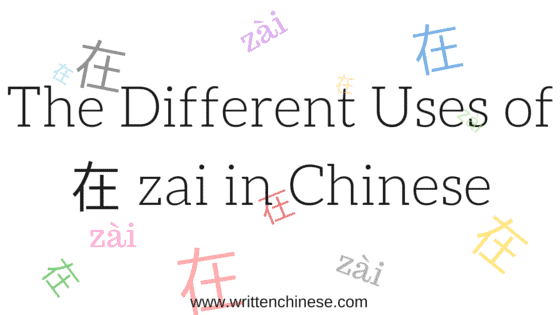The 在 (zài) character has several different uses, and since it’s a character that will appear soon after you begin learning Chinese, it’s a good idea to get yourself accustomed to its different functions. Most of them have to do with location, as primarily, 在 (zài) is used to express the phrase ‘to be located…’
Here are some rules and sentence patterns to follow when using the 在 (zài) character and also some advice on how not to use it:
1. Expressing location with 在 (zài)
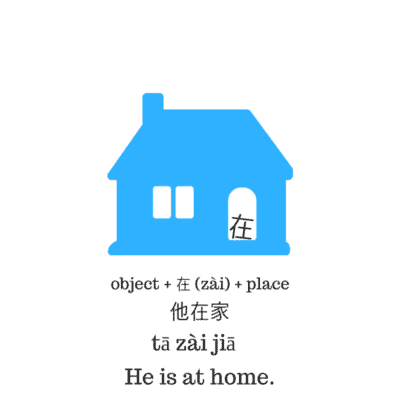
The 在 (zài) character can be used to indicate location and often be used to state ‘to be located at’.
subject + 在 + place
他在家。(tā zài jiā) He is at home.
The negation for 在 (zài) is 不在 (bú zài) :
他不在家。(tā bú zài jiā) He is not at home.
在 (zài) also functions as a preposition. It indicates locations where an action occurs. It is often used as ‘at’, ‘in’, ‘on’.
2. Indicating location with 在 (zài) before verbs
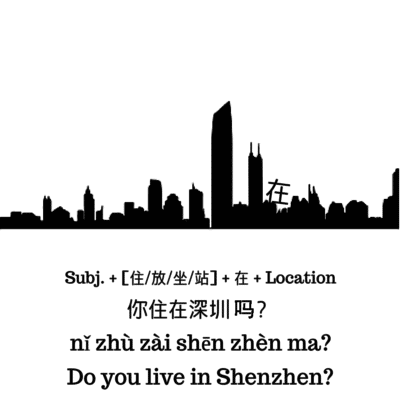
If you need to include the place where an action takes place, you can use 在 (zài).
To indicate the location that a verb takes place in, 在 (zài), followed by a location, comes before the verb.
Subj. + 在 + Place + Verb + Obj.
There are some verbs that do not follow the pattern above. These verbs include 住 (zhù), 放 (fàng), 坐 (zuò) and 站 (zhàn) and come after the verb.
Subj. + [住/放/坐/站] + 在 + Location
你住在深圳吗?(nǐ zhù zài shēn zhèn ma?) Do you live in Shenzhen?
3. Using 在 (zài) and 正在 (zhèng zài) to suggest ongoing actions in the present
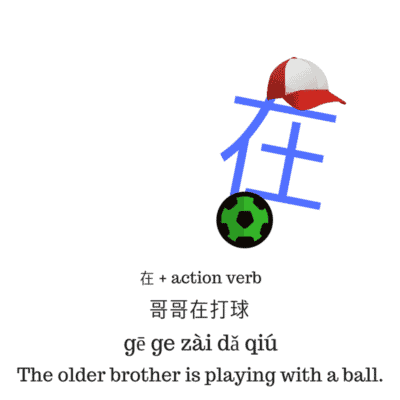
在 (zài) and 正在 (zhèng zài) can only be used with actions, not adjectival, stative or modal verbs.
哥哥在打球。(gē ge zài dǎ qiú) The older brother is playing with a ball.
我在看书,妈妈在洗碗。(wǒ zài kàn shū, mā ma zài xǐ wǎn) I am reading a book and mom is washing dishes.
4. Using 现在 (xiàn zài) in the present
现在 (xiàn zài) can be used when talking about actions occurring in the present.
汽油正在贵了。x
汽油现在贵了。√ (qì yóu xiàn zài guì le)
Oil is expensive now.
5. Using 在 (zài) for decisions
在 (zài) can sometimes be used to express an abstract idea. In this situation, 在 (zài) is used to mean ‘up to you’.
去不去在你。(qù bù qù zài nǐ) It is up to you if you go or not.
6. 在 (zài) to express the scope of something

In this case, 在 (zài) is combined with 方面 (fāng miàn) to make the phrase ‘in the area of…’ or ‘on the topic of…’
在 + subject/area + 方面 + comment
在音乐方面,他是个天才。(zài yīn yuè fāng miàn, tā shì gè tiān cái)
He is very talented musically.
7. 在 (zài) used to express existence and belief
妈妈对我们的关心无处不在。(mā ma duì wǒ men de guān xīn wú chù bú zài.)
Mother was concerned about us in every way.
Commonly seen errors when use 在 (zài)
1. Wrong position.
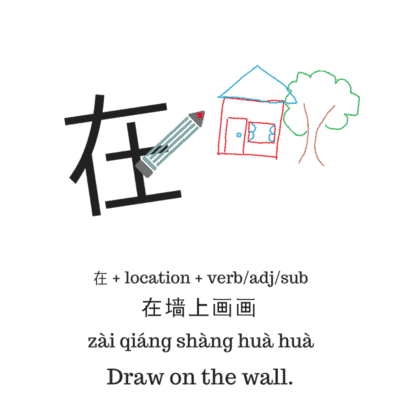
When 在 (zài) is used to express location or place there are several situations that can occur:
a) When the action occurs in the place mentioned then 在 (zài) should be used after the verb.
Object + verb + 在 + place
杯子在地上摔碎。×
杯子摔碎在地上。√ (bēi zi shuāi suì zài dì shang.)
The glass fell and broke on the ground.
b) If there is a location, then 在 (zài) should be used before the verb, adjective or subject.
在 + location + verb/adj/sub
画画在墙上。×
在墙上画画。√ (zài qiáng shàng huà huà)
Draw on the wall.
When certain verbs are used with a time phrase, 在 (zài) is used after the verb.
When expressing time appear/disappear and some other not obvious action, 在 (zài) is used after the verb.
Here are some examples of verbs that come before 在 (zài):
Monosyllabic Verbs: 生 (shēng), 死 (sǐ), 定 (dìng), 改 (gǎi), 放 (fàng), 排 (pái)
Bigrams: 出生 (chū shēng), 诞生 (dàn shēng), 发生 (fā shēng), 出现 (chū xiàn), 发现 (fā xiàn), 布置 (bù zhì), 安排 (ān pái), 确定 (què dìng), 固定 (gù dìng).
在一九九六年生。×
生在一九九六年。√ (shēng zài yī jiǔ jiǔ liù nián)
Born in 1996.
在下周,考试安排。×
考试安排在下周。√ (kǎo shì ān pái zài xià zhōu)
The exam is arranged for next week.
For other most verbs, 在 (zài) is generally used before verb.
2. Localizer missing at the end of a 在 (zài) sentence
When 在 (zài) is used to express location or scope, there should be a localizer at the end of the sentence.
在 + object + location
在…中 (zài…zhōng)
在…上 (zài…shàng)
在…方面 (zài…fāng miàn)

杯子在桌子。×
杯子在桌子上。√ (bēi zi zài zhuō zi shàng)
The glass is on the table.
钱包放在口袋。×
钱包放在口袋里。√ (qián bāo fàng zài kǒu dài lǐ)
The wallet is inside of the pocket.
3. Time noun phrase missing at the end of a 在 (zài) sentence
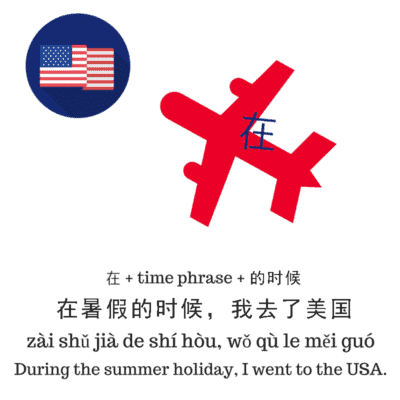
When 在 (zài) expresses time, there should be 的时候 (de shí hòu) at the end. 的时候 (de shí hòu) can be used to mean ‘when’ or ‘at that time’.
在 + time phrase + 的时候
在暑假,我去了美国。×
在暑假的时候,我去了美国。√ (zài shǔ jià de shí hòu, wǒ qù le měi guó.)
During the summer holiday, I went to the USA.
Exercises
Translate the English sentence into Chinese:
1. Don’t write your name in the book.
2. The time of the meeting has been changed to tomorrow morning.
3. People are used to eating rice in the south of China.
Post your sentences below. The answers can be found in the comment section of You & Me. This & That: Pronouns in Chinese!
